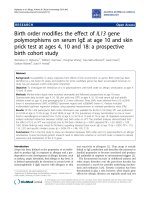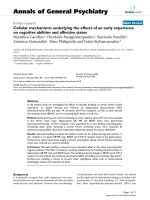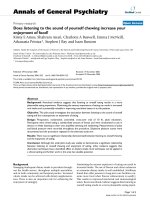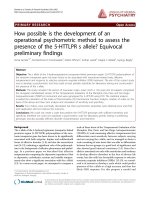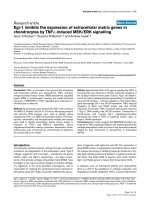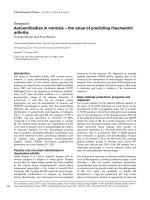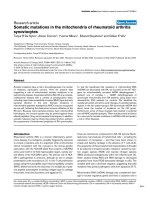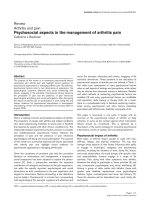Báo cáo y học: " Dental problems delaying the initiation of interferon therapy for HCV-infected patients" pptx
Bạn đang xem bản rút gọn của tài liệu. Xem và tải ngay bản đầy đủ của tài liệu tại đây (181.08 KB, 5 trang )
RESEARC H Open Access
Dental problems delaying the initiation of
interferon therapy for HCV-infected patients
Yumiko Nagao
1*
, Michio Sata
1,2†
Abstract
Background: There has been little discussion about the importance of oral management and interferon (IFN)
therapy, although management of the side effects of therapy for chronic hepatitis C has been documented. This
study determined whether dental problems delayed the initiation of IFN therapy for hepatitis C virus (HCV)-infected
patients.
Results: We analyzed 570 HCV-infected patients who were admitted to our hospital from December 2003 to June
2010 for treatment consisting of pegylated IFN (Peg-IFN) monotherapy or Peg-IFN/ribavirin combination therapy.
The group comprised 274 men and 296 women with a mean age 57.2 years. Of the 570 patients, six could not
commence Peg-IFN therapy, despite their admission, because of dental problems such as periodontitis, pupitis, and
pericoronitis. The ages of six whose dental problems delayed the initiation of Peg-IFN ranged from 25 to 67 years,
with a mean age of 47.3 ± 15.2 years. IFN therapy was deferred for 61.3 ± 47.7 days. Among the six subjects for
whom IFN treatment was delayed, only one had a salivary flow that was lower than the normal value.
Conclusions: Treatment of dental infections is required before IFN therapy for HCV infection can be started. To
increase the depth of understanding of oral health care, it is hoped that dentists and medical specialists in all areas
will hold discussions to generate cooperation.
Background
In Japan, hepatocellular carcinoma (HCC) is the fourth
leading cause of death in males and the sixth in females
according to a recent survey. The incidence of HCC has
increased in Japan t hroughout the past several decades
[1]. Hepatitis C virus (HCV) is the major cause of HCC
in Japan, with 70% of cases being HCV-related. It is
assumed that between one and two million Japanese
people are chronically infected with HCV [1].
Interfer on (IFN) therapy for chronic hepatit is C is the
only treatment for completely eliminating the virus.
Combination therapy with pegylated IFN (Peg-IFN ) and
ribavirin has been recommended widely as the first
choice for chronic hepatitis C patients with high viral
loads. The sustained virological response (SVR) rate
after 48 weeks of treatment at a standard dose is
approximately 40 to 50% [2-5]. It has been shown that
IFN therapy decreases the ra te of develo pment of HCC
and improves the long-term prognosis [6-9].
Although IFN therapy has therapeutic benefits, the
treatment produces a number of well-described side
effects that a re dom inated by fatigue, influenza-like syn-
drome and neuropsychiatric symptoms [2-5,10-12] and
mana gement of such side effects is required during ther-
apy. Among the side effects in a Japanese Phase III trial of
Peg-IFN alfa-2a/alfa-2b and ribavirin, dental problems
have been docu mented in patients with chronic hepatitis
C. Meanwhile, it has been reported that hepatitis C
infected patients have significant oral health needs [13-16]
and that experience of dental caries is si gnificantly worse
for HCV-infected patients than patients in general [13].
Therefore, in the present study, we determined
whether dental problems delayed the initiation of IFN
therapy for HCV-infected patients.
Methods
Patients
A total of 570 HCV-infected patients who admitted to
the Kurume University Hospital from December 2003
* Correspondence: u.ac.jp
† Contributed equally
1
Department of Digestive Disease Information & Research, Kurume University
School of Medicine, Kurume, Fukuoka, 830-0011, Japan
Full list of author information is available at the end of the article
Nagao and Sata Virology Journal 2010, 7:192
/>© 2010 Nagao and Sata; licensee BioMed Central Ltd. This is an Open Access article distribu ted u nder the terms of the Creative
Commons Attribution License ( which permits unr estricted use, distribution, and
reproduction in any medium, provided the original work is properly cited.
to June 2010 for treatment with Peg-IFN monother-
apy or Peg-IFN/ribavirin combination therapy were
studied (Table 1). The 570 patients were 274 men
and 296 women with a mean age of 57.2 ± 11.6 years.
They were consulted by one oral surgeon for each
patient about presence of oral infection before com-
mencing IFN treatment. All HCV-infected patients
treated with IFN therapy at our hospital were
required to undergo hospitalization for two weeks for
therapeutic management and education about liver
diseases.
We determined whether dental problems delayed the
initiation of IFN therapy for these patients. Patients who
underwent Peg-IFN therapy during dental treatment
were excluded. Informed consent was obtained from all
patients after the purpose and methods of the study
were explained.
Salivary flow
We used a simple and low-cost test for xerostomia
detection, which requires chewing on a piece of gauze
for 2 min. The results from 531 of 570 patients were
quantified using the Saxon test. A salivary flow rate
≤ 2 g/2 min was judged as decreased salivary secretion.
Serological assays
Serum samples were examined for the presence or
absence of markers of HCV and HBV infection. The
HCV RNA level before IFN therapy was analyzed by
quantitative PCR assay (COBAS AMPLICOR HCV
MONITOR v 2.0 Test, COBAS AmpliPrep/COBAS Taq-
Man H CV Test, Roche Molecula r Systems, New Jersey,
US) [17,18]. HCV genotype was determined by polymer-
ase chain reaction assay, using a mixture of primers for
the subtype, as reported previously [19].
Table 1 Characteristics of 570 patients
Men/Women 274/296
Age (mean ± SD) years 57.2 ± 11.6
Liver disease AH-C 1 (0.2%)
CH-C 471 (82.6%)
CH-(B+C) 3 (0.5%)
CH-C and post HCC treatment 20 (3.5%)
LC-C 45 (7.9%)
LC-C and post HCC treatment 30 (5.3%)
Peg-IFN therapy Peg-IFN alfa-2a monotherapy 104 (18.2%)
Peg-IFN alfa-2a monotherapy and trial 1 (0.2%)
Peg-IFN alfa-2a/RBA 14 (2.5%)
Peg-IFN alfa-2a/RBA and trial 5 (0.9%)
Peg-IFN alfa-2b/RBA 438 (76.8%)
Peg-IFN alfa-2b/RBA®Peg-IFN alfa-2a monotherapy 4 (0.7%)
Peg-IFN alfa-2b/RBA®Peg-IFN alfa-2a monotherapy®Peg-IFN alfa-2a/RBA 1 (0.2%)
Peg-IFN alfa-2b/RBA®Peg-IFN alfa-2a monotherapy®Peg-IFN alfa-2b/RBA 1 (0.2%)
Peg-IFN alfa-2b/RBA®Peg-IFN alfa-2a/RBA 2 (0.4%)
HCV genotype 1a 2 (0.4%)
1a or 1b 1 (0.2%)
1b 401 (70.4%)
2a 121 (21.2%)
2b 24 (4.2%)
3a 1 (0.2%)
combination (1a and 1b) 1 (0.2%)
combination (1b and 2b) 1 (0.2%)
combination (1b and 3a) 1 (0.2%)
combination (2a and 2b) 2 (0.4%)
indeterminable 3 (0.5%)
untested 12 (2.1%)
CH-C: chronic hepatitis C, CH-(B+C): chronic hepatitis B and C, LC-C: liver cirrhosis, HCC: hepatocelular carcinoma, Peg-IFN: pegylated interferon, RBV: ribavirin
Nagao and Sata Virology Journal 2010, 7:192
/>Page 2 of 5
Therapeut ic response was judged after IFN therapy as:
SVR - normalization of alanine aminotranferase (ALT)
levels and HCV RNA negative for six months or more
after treatment; transient response (TR) - normalization
of ALT levels and undetectable HCV RNA during IFN
treatment b ut HCV RNA-positive after IFN treatment;
non-responder (NR) - neither normal nor negative
results for six months or more.
As shown in Table 1, chronic hepatitis C with HCV
genoty pe 1b was the most common. Patients with geno-
types 2a/2b underwent Peg-IFN monotherapy and those
with genotypes 1a/1b, a combinat ion of Peg-IFN and
ribavirn.
Results
Dental problems delayed the initiation of IFN therapy
Of 570 patients with HCV-related liver diseases, we
documented six whose dental problems delayed the
initiation of Peg-IFN therapy. Their ages ranged from
25 to 67 years, with a mean age of 47.3 ± 15.2 years.
There w ere two men and four women (Table 2). These
six patients could not commence IFN therapy, despite
their admission for this treatment, and their therapy was
deferred for 61.3 ± 47.7 da ys. Patient no. 1 had an acute
odontogenic periostitis , resulting from periapical inflam-
mation of endodontic origin. This was t reated success-
fullybynonsurgicalendodontics and administration of
antibiotics. Patient no. 2 had an acute alveolar abscess,
resulting from periodontal disease. His four molars were
extracted after local anti-inflammation treatment.
Patient no. 3 had a periapical periodontitis of the right
mandibular second molar. The molar was extracted.
Patient no. 4 had multiple dental problems with pain.
After extirpation of dental pulps and extraction of teeth,
she received IFN treatment. Patient no. 5 had apical per-
iodontitis with gingiv al abscess, consequently her teeth
were endodontically treated. Patient no. 6 had trismus
and painful swallowing caused by pericoronitis of her
Table 2 Characteristics of six patients whose dental problems delayed the initiation of IFN therapy
No. Age Sex Liver
Disease
HCV RNA HCV
genotype
Dental problems that delayed the
initiation of Peg-IFN therapy
Period to
onset of IFN
treatment
after dental
therapy (days)
Underlying
disease
IFN
therapy
Effect of
IFN
treatment
1 50 F CH-C 980 kIU/ml 1b #1. Acute periostitis of the right
maxilla, #2. Periapical periodontitis
of the right maxillary first molar
49 Gallbladder polyp Peg-IFN
alfa-2b/
RBA
TR
2 67 M CH-C 3,940 kIU/
ml
1b #1. Acute alveolar abscess of
bilateral mandibular molars, #2.
Periodontal diseases of the right
mandibular first and second molars,
the left mandibular first molar, and
the left maxilla first and second
molars
105 Gastric ulcer Peg-IFN
alfa-2b/
RBA
NR
3 36 M CH-C over 500
kIU/ml
1b Periapical periodontitis of the right
mandibular second molar
4 None Peg-IFN
alfa-2b/
RBA
SVR
4 47 F CH-C 43 kIU/ml 2a #1. Pulpitis of the right maxillary first
premolar, the left maxillary second
premolar, and the right mandibular
second premolar, #2. Tooth stumps
of the left maxillary canine and
second premolar, and the right
mandibular first premolar, #3. Dental
caries of the right maxillary lateral
incisor
97 Hypertension,
Adjustment
disorder,
Gallstone
Peg-IFN
alfa-2a
SVR
5 59 F LC-C 471 kIU/ml 2a #1. Periapical periodontitis and
gingival abscess of the right
mandibular lateral incisor, #2. Dental
caries of bilateral mandibular central
incisors
105 Depression,
Hypertension,
Osteoarthritis of
the spine,
Esophageal
varices
Peg-IFN
alfa-2b/
RBA
SVR
6 25 F CH-C 6.2 logIU/
mL
1b #1. Pericoronitis of the right
mandibular wisdom tooth, #2.
Horizontal impacted wisdom teeth
of bilateral mandibles
8 None Peg-IFN
alfa-2b/
RBA
SVR
CH-C: chronic hepatitis C, LC-C: liver cirrhosis, Peg-IFN: pegylated interferon, RBV: ribavirin,
TR: transient biochemical responders, NR: nonresponder, SVR: sustained virological response
Nagao and Sata Virology Journal 2010, 7:192
/>Page 3 of 5
wisdom tooth and she had a high white blood cell count
of 10,200/mm3 on the day of admissi on. All six patients
received IFN treatment after their dental treatment was
completed. Nobody suffered from diabetes mellitus. The
outcome of the patients was classified into three groups:
SVR (n = 4), TR (n = 1), and NR (n = 1).
Salivary flow
The level of total saliva production, measured usi ng the
Saxon test, was 4.26 ± 1.91 g/2 min. The salivary flow
rate was below the normal value in 54 patients (10.2%).
Among the six s ubjects for whom IFN treatment was
delayed, only one had a salivary flow that was lower
than the normal value.
Discussion
The results indicate that oral health care may be
required before HCV-infected patients undergo IFN
therapy. In our study, dental problems delayed the
initiation of IFN therapy for a maximum of 105 days.
HCV-infected patients treated with IFN therapy should
be managed by intensive oral care because of lower
resistance to infection during the therapy.
Poor of oral health has been reported for HCV-
infected patients [13-16]. Coates et al. repor ted that the
dental caries experience of H CV-infected subjects was
significantly worse than that of patients in general, that
the number of teeth missing from patients with hepatitis
C infection also was significantly higher than for
patients in general, and that periodontal health tended
to be poor [13]. Griffin et al. found that patients with
rheumatoid arthritis, diabetes or a liver condition were
twice as likely to have a n urgent need for dental treat-
ment as patients who did not have these diseases and
documented a high burden of unmet dental care needs
among patients with chronic diseases [16]. The authors
showed that HCV was t he strongest predictor of
patients reporting poor oral health.
Japanese HCV-infected patients tend to be older than
those in other countries and their older age favors the
onset of HCC, leading to an incre ased mortality rate [1].
Peg-IFN-ribavirin combination therapy is the standard
treatment for chronic hepatitis C. Meanwhile, the fre-
quency of adverse events in combination therapy is rela-
tively high (20-64%) [2-5,10-12].
In a Japanese Phase III trial of Peg-IFN alfa-2a and
ribavirin involving 199 patients with chronic hepatitis C,
including 99 patients with IFN treatment-naive genotype
1 and 100 patients with patients whom had not had a
SVR a fter IFN therapy, the oral side effects w ere: gingi-
val bleeding and gingival swelling (6%), toothache
(4.5%), gingivitis and periodontitis (3%), dental caries
(1.5%), stomatitis and cheilitis (19.1%), disorder of taste
(15.6%), dry mouth (6.5%), glossalgia and glossitis
(4.5%), perioral pares thesia (2.5%), oral pain (0.5%), oral
mucosal damage (0.5%), oral lic hen planus (0.5%), oral
hemorrhage (0.5%), d ry lip (0.5%), and bulla of lip
(0.5%). On the other hand, in a Japanese Phase III trial
of Peg-IFN alfa-2b and ribavirin involving 332 chronic
hepatitis C patients, including 269 patients for 48 weeks
treatment duration with genotype 1b and high virus
load, and 63 patients for 24 weeks treatment duration
with others, oral side effect were: dental pulpitis, gingivi-
tis, and periodontitis (8.9%), toothache (7.1%), dental
abnormity (1.1%), stomatitis and cheilitis (26.8%), disor-
der of taste (26.8%), dry mouth (15.6%), glossiti s (5.9%),
oral discomfort feeling (2.6%), oral hemorrhage (0.4%),
oral pain (0.4%), dry tongue (0.4%), decreased secretion
of saliva (0.4%).
These findings indicate that dental management of
HCV-infected patients is required before IFN therapy.
However, in Japan the importance of oral health is often
overlooked in HCV-infected patients and has not been
discussed in detail up to now.
Several studies have shown an association between
HCV and sicca symptoms [20,21]. Patien ts with chronic
HCV infection also have been reported to be at a
greater risk of developing insulin resistance [22,23].
Severe periodontal disease causes insulin resistance [24].
The reasons that HCV-infected individuals had pro-
blems such a s dental caries and oral health care may
include a decrease d salivary flow rate, elicitation of peri-
odontal disease by insulin resistance and difficulties f or
radical dental treatment of patients with liver disease
who may have problems such as prolonged bleeding.
Henderson et al. reported HCV-infected cases and
suggested the possibility of occasional discrimination by
practitioners. They concluded that more effe ctive oral
health education is required for HCV-infected patients
and dental practitioners [15]. We distributed a question-
naire to 209 patients who visited our hospital for liver
disease treatment to determine whether patients with
HCV or h epatitis B virus (HBV) disclosed their disease
status to the personnel in dental clinics. We found that
59.8% always did so, 12.0% sometimes did so and 28.2%
never did so. The main reason for nondisclosure was
failure of dental healthcare workers to ask whether
patients had systemic disease. Other reasons included
fear of negative reactions from healthcare worke rs and
not wanting dentists or staff to know their specific liver
ail ment [25]. To increa se the depth of understanding of
oral health care, it is hoped that dentists and medical
specialists in all areas will hold discussions to create
cooperation.
Conclusions
In conclusion, the results of this study show that the
treatment of dental infection is required before IFN
Nagao and Sata Virology Journal 2010, 7:192
/>Page 4 of 5
therapy for HCV infection. On the basis of our results,
we introduced systems in our hospital from November
2009 to ensure complete dental treatment before IFN
therapy. We should enhance mutual understanding of
various issues related to HCV-infected persons between
the patient and the physician.
Abbreviations
HCV: hepatitis C virus; HCC: hepatocellular carcinoma; IFN: interferon; Peg-
IFN: pegylated IFN; SVR: sustained virological response; TR: transient
response; NR: non-responder
Acknowledgements
This study was supported in part by a Grant-in-Aid for Scientific Research (C)
(No. 22592354) from the Ministry of Education, Culture, Sports, Science and
Technology of Japan, and was supported in part by Health and Labour
Sciences Research Grants for Research on Hepatitis from the Ministry of
Health, Labour and Welfare of Japan.
Author details
1
Department of Digestive Disease Information & Research, Kurume University
School of Medicine, Kurume, Fukuoka, 830-0011, Japan.
2
Division of
Gastroenterology, Department of Medicine, Kurume University School of
Medicine, Kurume, Fukuoka, 830-0011, Japan.
Authors’ contributions
YN carried out most of the data collection and drafted the manuscript. MS
contributed to data analysis. All authors read and approved the final
manuscript.
Competing interests
The authors declare that they have no competing interests.
Received: 22 July 2010 Accepted: 17 August 2010
Published: 17 August 2010
References
1. Yoshizawa H: Hepatocellular carcinoma associated with hepatitis C virus
infection in Japan: projection to other countries in the foreseeable
future. Oncology 2002, 62(Suppl 1):8-17.
2. Hadziyannis SJ, Settee H Jr, Morgan TR, Balan V, Diago M, Marcellin P,
Ramadori G, Bodenheimer H Jr, Bernstein D, Rizzetto M, Zeuzem S,
Pockros PJ, Lin A, Ackrill AM, PEGASYS International Study Group:
Peginterferonalpha 2a and ribavirin combination therapy in chronic
hepatitis C: A randomized study of treatment duration and ribavirin
dose. Ann Intern Med 2004, 140:346-355.
3. Manns MP, McHutchison JG, Gordon SC, Rustgi VK, Shiffman M,
Reindollar R, Goodman ZD, Koury K, Ling M, Albrecht JK: Peginterferon
alfa-2b plus ribavirin compared with interferon alfa-2b plus ribavirin for
initial treatment of chronic hepatitis C: a randomized trial. Lancet 2001,
358:958-965.
4. Fried MW, Shiffman ML, Reddy KR, Smith C, Marinos G, Gonçales FL Jr,
Häussinger D, Diago M, Carosi G, Dhumeaux D, Craxi A, Lin A, Hoffman J,
Yu J: Peginterferon alfa-2a plus ribavirin for chronic hepatitis C virus
infection. N Engl J Med 2002, 347:975-982.
5. Mangia A, Minerva N, Bacca D, Cozzolongo R, Ricci GL, Carretta V, Vinelli F,
Scotto G, Montalto G, Romano M, Cristofaro G, Mottola L, Spirito F,
Andriulli A: Individualized treatment duration for hepatitis C genotype 1
patients: a randomized controlled trial. Hepatology 2008, 47:43-50.
6. Yoshida H, Shiratori Y, Moriyama M, Arakawa Y, Ide T, Sata M, Inoue O,
Yano M, Tanaka M, Fujiyama S, Nishiguchi S, Kuroki T, Imazeki F,
Yokosuka O, Kinoyama S, Yamada G, Omata M: Interferon therapy reduces
the risk for hepatocellular carcinoma: national surveillance program of
cirrhotic and noncirrhotic patients with chronic hepatitis C in Japan. IHIT
Study Group. Inhibition of Hepatocarcinogenesis by Interferon Therapy.
Ann Intern Med 1999, 131:174-181.
7. Yoshida H, Arakawa Y, Sata M, Nishiguchi S, Yano M, Fujiyama S, Yamada G,
Yokosuka O, Shiratori Y, Omata M: Interferon therapy prolonged life
expectancy among chronic hepatitis C patients. Gastroenterology 2002,
123:483-491.
8. Okanoue T, Itoh Y, Minami M, Sakamoto S, Yasui K, Sakamoto M, Nishioji K,
Murakami Y, Kashima K: Interferon therapy lowers the rate of progression
to hepatocellular carcinoma in chronic hepatitis C but not significantly
in an advanced stage: a retrospective study in 1148 patients. Viral
Hepatitis Therapy Study Group. J Hepatol 1999, 30:653-659.
9. Mazzaferro V, Romito R, Schiavo M, Mariani L, Camerini T, Bhoori S,
Capussotti L, Calise F, Pellicci R, Belli G, Tagger A, Colombo M, Bonino F,
Majno P, Llovet JM, HCC Italian Task Force: Prevention of hepatocellular
carcinoma recurrence with alpha-interferon after liver resection in HCV
cirrhosis. Hepatology 2006, 44:1543-1554.
10. Fried MW: Side effects of therapy of hepatitis C and their management.
Hepatology 2002, 36(5 Suppl 1):237-244.
11. Russo MW, Fried MW: Side effects of therapy for chronic hepatitis C.
Gastroenterology 2003, 124 :1711-1719.
12. Hoofnagle JH, Seeff LB: Peginterferon and ribavirin for chronic hepatitis
C. N Engl J Med 2006, 355 :2444-2451.
13. Coates EA, Brennan D, Logan RM, Goss AN, Scopacasa B, Spencer AJ,
Gorkic E: Hepatitis C infection and associated oral health problems. Aust
Dent J 2000, 45:108-114.
14. Coates EA, Walsh L, Logan R:
The increasing problem of hepatitis C virus
infection. Aust Dent J 2001, 46:13-17.
15. Henderson L, Muir M, Mills PR, Spence E, Fox R, McCruden EA, Bagg J: Oral
health of patients with hepatitis C virus infection: a pilot study. Oral Dis
2001, 7:271-275.
16. Griffin SO, Barker LK, Griffin PM, Cleveland JL, Kohn W: Oral health needs
among adults in the United States with chronic diseases. J Am Dent
Assoc 2009, 140:1266-1274.
17. Lee SC, Antony A, Lee N, Leibow J, Yang JQ, Soviero S, Gutekunst K,
Rosenstraus M: Improved version 2.0 qualitative and quantitative
AMPLICOR reverse transcription-PCR tests for hepatitis C virus RNA:
calibration to international units, enhanced genotype reactivity, and
performance characteristics. J Clin Microbiol 2000, 38:4171-4179.
18. Sizmann D, Boeck C, Boelter J, Fischer D, Miethke M, Nicolaus S, Zadak M,
Babiel R: Fully automated quantification of hepatitis C virus (HCV) RNA in
human plasma and human serum by the COBAS AmpliPrep/COBAS
TaqMan system. J Clin Virol 2007, 38:326-333.
19. Dusheiko G, Schmilovitz-Weiss H, Brown D, McOmish F, Yap PL, Sherlock S,
McIntyre N, Simmonds P: Hepatitis C virus genotypes: an investigation of
type-specific differences in geographic origin and disease. Hepatology
1994, 19:13-18.
20. Carrozzo M: Oral diseases associated with hepatitis C virus infection. Part
1. sialadenitis and salivary glands lymphoma. Oral Dis 2008, 14:123-130.
21. Nagao Y, Hanada S, Shishido S, Ide T, Kumashiro R, Ueno T, Sata M:
Incidence of Sjögren’s syndrome in Japanese patients with hepatitis C
virus infection. J Gastroenterol Hepatol 2003, 18:258-266.
22. Serfaty L, Capeau J: Hepatitis C, insulin resistance and diabetes: clinical
and pathogenic data. Liver Int 2009, 29(Suppl 2):13-25.
23. Nagao Y, Kawasaki K, Sata M: Insulin resistance and lichen planus in
patients with HCV-infectious liver diseases. J Gastroenterol Hepatol 2008,
23:580-585.
24. Nishimura F, Murayama Y: Periodontal inflammation and insulin
resistance - lessons from obesity. J Dent Res 2001, 80:1690-1694.
25. Nagao Y, Kawaguchi T, Ide T, Sata M: HCV or HBV infection self-disclosure
to dentist. Kansenshogaku Zasshi 2008, 82:213-219.
doi:10.1186/1743-422X-7-192
Cite this article as: Nagao and Sata: Dental problems delaying the
initiation of interferon therapy for HCV-infected patients. Virology Journal
2010 7:192.
Nagao and Sata Virology Journal 2010, 7:192
/>Page 5 of 5

